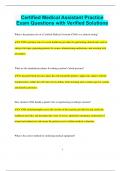Certified Medical Assistant Practice
Exam Questions with Verified Solutions
What is the primary role of a Certified Medical Assistant (CMA) in a clinical setting?
✔✔A CMA's primary role is to assist healthcare providers by performing clinical tasks such as
taking vital signs, preparing patients for exams, administering medications, and assisting with
procedures.
What are the standard procedures for taking a patient’s blood pressure?
✔✔To measure blood pressure, place the cuff around the patient’s upper arm, align it with the
brachial artery, inflate the cuff, then slowly deflate while listening with a stethoscope for systolic
and diastolic pressures.
How should a CMA handle a patient who is experiencing an allergic reaction?
✔✔A CMA should promptly assess the severity of the reaction, provide first aid, notify the
healthcare provider, and document the event. If severe, administer emergency medications if
trained and authorized, and ensure the patient receives further medical evaluation.
What is the correct method for sterilizing medical equipment?
1
,✔✔Sterilization can be achieved through methods such as autoclaving, which uses high-pressure
steam, or chemical sterilants. Equipment should be cleaned thoroughly before sterilization to
ensure effectiveness.
Describe the steps for performing a urinalysis.
✔✔To perform a urinalysis, collect a urine sample in a sterile container, test the sample using
dipsticks or automated analyzers for various parameters such as pH, protein, glucose, and
specific gravity, and document the results.
What is the importance of HIPAA compliance in a medical office?
✔✔HIPAA compliance ensures the protection of patient privacy and confidentiality by setting
standards for handling, storing, and transmitting patient information securely.
How should a CMA prepare a patient for an ECG (Electrocardiogram)?
✔✔Prepare the patient by explaining the procedure, ensuring they are comfortable and relaxed,
and placing electrodes on their chest, arms, and legs according to the standardized placement
guidelines.
What are the key components of a patient’s medical history that a CMA should document?
2
,✔✔Key components include the patient’s personal information, past medical history, family
history, current medications, allergies, and any symptoms or concerns relevant to their current
visit.
What is the procedure for disposing of hazardous materials in a medical office?
✔✔Hazardous materials should be disposed of according to regulatory guidelines, including
using designated biohazard containers for sharps and contaminated waste, and following proper
disposal protocols for chemicals and medications.
How should a CMA handle and store patient records?
✔✔Patient records should be stored securely, either in locked physical cabinets or encrypted
digital systems, with restricted access to authorized personnel only, to ensure confidentiality and
compliance with privacy regulations.
Which of the following planes divides the body into anterior and posterior portions?
✔✔Transverse
Which of the following systems pumps and distributes blood throughout the body?
✔✔Cardiovascular
3
, The 4 major types of tissue in the body are ✔✔Muscle, nervous, epithelial, and connective
The upper respiratory tract includes all of the following EXCEPT the ✔✔Bronchi
The accessory organs include the ✔✔Gallbladder, liver, and pancreas
Hydrocele means ✔✔Swelling of the testes
All of the following are true about leukocytes EXCEPT ✔✔Leukocytes are responsible for blood
clotting
Tendonitis is a(n) ✔✔Inflammation of the tendon
The function of the skin includes all of the following EXCEPT ✔✔Transportation of immune
cells
The nucleus is ✔✔The control center that directs the activity of the cell
4




